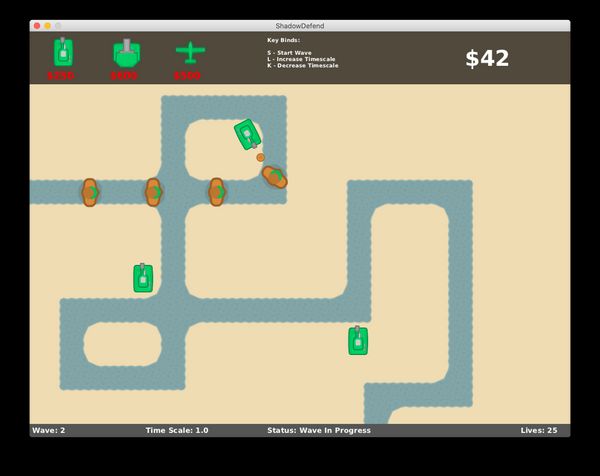
| Project Summary | |
|---|---|
| Title | Shadow Defend |
| Language | Java |
| Specification | Download PDF |
| Code | Repo Link |
Table of Contents
# Introduction
In the spring of 2020, I studied abroad at the University of Melbourne in Australia. One of my classes, SWEN20003, focused on software development using object-oriented principles. Taught in Java, lectures introduced concepts such as abstract classes, generics, and other topics. During weekly programming workshops, the focus was on implementing specific design patterns like an observer, factory, or flyweight.
The final assignment involved a large project that would apply what we had learned during the semester. The task was to create a tower defense game, titled Shadow Defend, using the specification provided to us. While we were given Bagel, a simple graphics engine, the actual game logic implementation was left up to us.
# Designing the Game
The actual assignment was split into two parts. The first task was to produce a class design that demonstrated our plan for the game’s implementation. This took the form of a UML diagram that modeled each entity in the game and the relationships between them (download PDF). While I did not follow this plan exactly, I found that it helped me anticipate many of the challenges that would come up during implementation.
# Implementing the Game
The final implementation for Shadow Defend followed not only our UML diagram but also our earlier work in the course. In a previous assignment (repo link), we had already created a skeleton for a tower defense game. However, it lacked most of the features that would be required in the final project. Of note, the game would need to handle multiple enemy types, purchasing new towers, and a status panel to track information.
# Timescale Changes
These requirements were further complicated by the need to handle timescale changes during play. By pressing the L or K keys, the player is able to increase or decrease the speed of the game. While the skeleton game used System.nanoTime() to track elapsed time, this proved to make certain actions more difficult. For example, the timing of enemy spawns would become out of sync under many circumstances. For the final project, I simply counted the number of elapsed frames when calculating timings. Even if this tied the game’s logic to the speed of the computer running it, it at least matched the instructor solution perfectly.
# Event Loop
Internally, Shadow Defend uses a single main loop to update the the game state. When updating, the game first checks if the player has run out of lives (which immediately exits the game). The map is then drawn, starting from the top-left of the game window. This accounts for the need to draw other objects on top of the background later on. The game then checks the state of the current level, updating it if the level has not been completed. Finally, the game updates each entity in play before drawing the user interface at the top and bottom of the screen.
# Game Objects
In order to share common attributes and behaviors, every game object inherits from an abstract GameObject class. In other words, enemies (called Splicers), towers, projectiles, and even purchasable items are all extensions of this base class. Each GameObject has a sprite, a rectangular bounding box, and a rotation that represents its appearance and spatial properties. Additionally, every subclass overrides a common update() method that will update entity state. This last feature means all active game objects can be tracked in the same list, with update() being called in a loop for each one.
Combining abstract classes along with Java streams simplified many operations. For example, the following method checks if any Slicers are still in play:
public boolean slicersInPlay() {
return entities.stream().anyMatch(o -> o instanceof Slicer);
}Certain game objects use additional logic for spawning or update behavior. Projectiles, for example, are instantiated with an intended target Slicer. If a projectile hits (intersects with) its target, the projectile will call a takeDamage() function implemented in the Slicer abstract class. In turn, specific enemy types are represented internally by extensions of this base class and spawned using a SlicerFactory.
# Level Representation
The game consists of multiple levels, each containing multiple waves in which enemies can spawn. While it was given that all levels would use the same series of waves (sharing what enemies spawned and how often those enemies spawned), the format for describing waves could not be changed. More specifically, waves were provided in the file waves.txt. Each line described a wave event within a particular wave:
1,spawn,20,slicer,1000
2,spawn,5,slicer,1000
2,delay,2500
2,spawn,20,slicer,750
3,spawn,5,superslicer,1000
…Ignoring the actual meaning of each comma-separated value, it was necessary to process the text file before the start of the game. For each level in Shadow Defend, the game reads each line of waves.txt and adds the corresponding wave information. Two additional classes, Level and Wave, control state management for levels and waves respectively. Since waves can contain either delay events or spawn events, both events are subclassed from a base WaveEvent class. It is also in this base class that the logic for triggering an event’s behavior is contained:
if (frameCount / ShadowDefend.getFPS() * MILLISECONDS_PER_SECOND >= delay)
activateBehavior();In general, any object that needed to track time (waves, certain projectiles, and towers) received that information directly from the running instance of Shadow Defend.
# Final Thoughts
This assignment was a pleasant surprise, but not for the reasons you might expect. I had used game engines in the past, namely Unity. However, the difference here was the simplicity of the Bagel graphics library. It was up to me to implement features that I had previously taken for granted in more advanced engines. While I certainly used many design patterns for the game, I learned almost as much about game engines themselves.
The source code for Shadow Defend and instructions on how to play it are available online at https://github.com/thisstillwill/SWEN20003-S1-2020-Project-2.